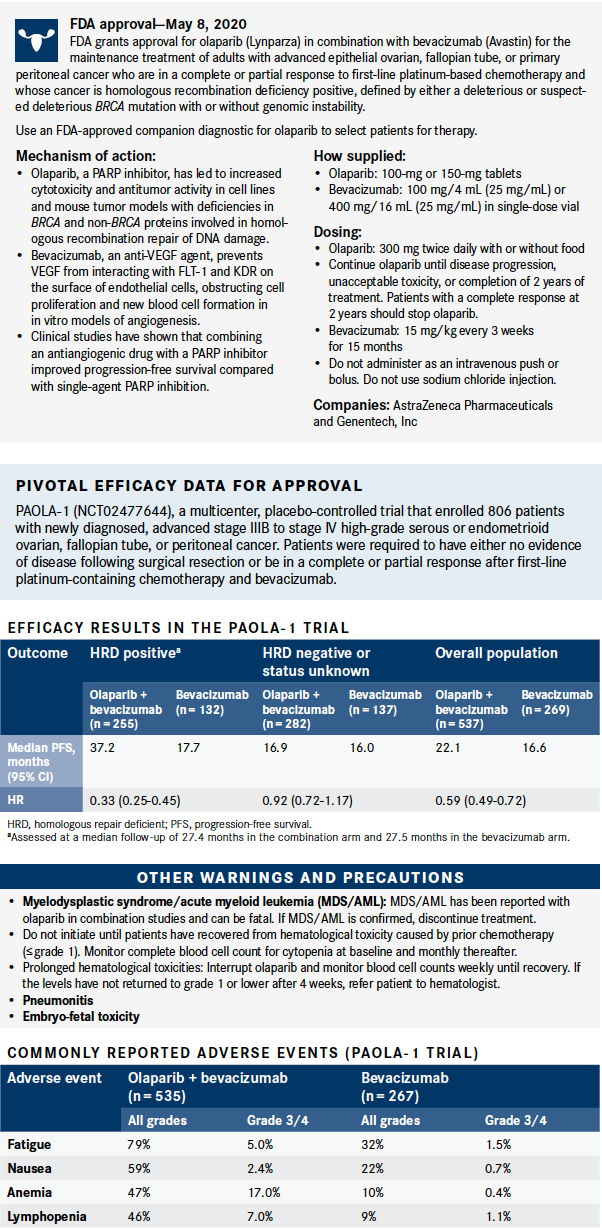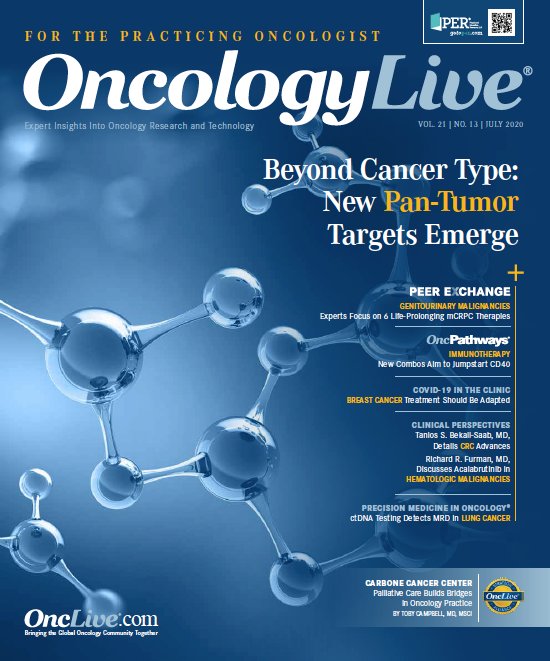Olaparib Plus Bevacizumab Combination Expands Options in HRD+ Cancer
Shannon N. Westin, MD, MPH, discusses the rationale for administering the maintenance therapy in this setting and the broader potential of regimens combining PARP with other therapies.
Shannon N. Westin, MD, MPH

Disease control strategies in the epithelial ovarian, fallopian tube, and primary peritoneal cancer maintenance settings now include the PARP inhibitor olaparib (Lynparza) in combination with bevacizumab (Avastin).
On May 8, 2020, the FDA approved olaparib in combination with bevacizumab as a first-line maintenance option for adults who are in a complete response (CR) or partial response (PR) to first-line platinum-based chemotherapy and whose disease is homologous recombination deficient (HRD), defined by either a deleterious or suspected deleterious BRCA mutation and/or genomic instability.1

The approval was based on efficacy data from the phase 3 PAOLA-1 trial (NCT02477644), in which the dual drug approach significantly improved progression-free survival compared with bevacizumab monotherapy in patients with HRD-positive tumors (37.2 vs 17.7 months; HR, 0.33; 95% CI, 0.25-0.45).1

In an interview with OncologyLive®, Shannon N. Westin, MD, MPH, director of early drug development and phase 1 trials in the Department of Gynecologic Oncology and Reproductive Medicine at The University of Texas MD Anderson Cancer Center in Houston, discussed the rationale for administering the maintenance therapy in this setting and the broader potential of regimens combining PARP with other therapies.
OncLive: How great was the need for a maintenance therapy for this population?
Westin: [For patients with] stage III or IV ovarian cancer, there’s an 80% chance of their cancer going into no evidence of disease, but unfortunately, about 70% to 80% of patients’ disease will recur, and when it recurs, it is much harder to cure. So we have been trying to expand the use of maintenance strategies to really take advantage of that early response rate and gain additional survival time for patients.
What was significant about the efficacy data that led to the approval?
What was really noteworthy was the [efficacy data’s] correlation to the presence of biomarkers. The patients who got the biggest benefit [from the therapy] were those with some type of BRCA mutation. [We also saw similar] and impressive activity in the group who had HRD tumors. We saw hazard ratios of 0.31 in the patients with BRCA mutations and 0.33 in the HRD group.
There was the expectation that bevacizumab and olaparib could potentially have a greater impact in homologous recombination–proficient patients; however, that was not the case. There was equivalent activity in the 2 arms: the bevacizumab alone arm and the arm that added the olaparib to the bevacizumab. These were interesting and surprising findings.
Are there any toxicities of note when administering this regimen?
I think the most important thing is that the majority of patients were able to stay on the regimen, but sometimes it did require dose adjustments and the addition of other medications for control. The most common grade 3 and 4 adverse events are hypertension and bone marrow issues such as anemia, lymphopenia, and neutropenia. These are [toxicities] that we know we can manage; you just need to be aware of them and vigilant in identifying them.
With the addition of bevacizumab to olaparib, there is no question that you are going to see hypertension. This is expected, so you need to make sure that you have your patients checking their blood pressure at home and are ready to [administer] an antihypertensive [if necessary].
How does this doublet therapy fit into the current treatment paradigm?
I think that for me and for many, the first question is going to be “What are you going to start the patient on?” Because [to use] this regimen, you need to be deciding [whether or not you will use it] basically at the onset of treatment, whereas [with] some of the other agents that are indicated in the maintenance setting, you can wait, do whatever you want in the beginning, and then start your maintenance.
There are some clinicians [who] use bevacizumab for all patients, and there are others [who] use a more nuanced strategy where they would typically reserve bevacizumab and chemotherapy for patients with stage IV disease [for example]. It will come down to what the clinician determines [regarding the] need for the use of bevacizumab; then they can add olaparib at the maintenance [stage].
[Importantly,] this is not a maintenance strategy that needs to continue forever. The PARP inhibition is given for 24 months, and the bevacizumab is [administered] for 15 months, so there is an end point in sight.
What are the next steps for this regimen?
Several ongoing trials are looking at [PARP inhibition combined with] other agents. Over the last year, we have seen approvals for PARP inhibitors alone, as well as this most recent approval with olaparib and bevacizumab, and a number of different studies are either completed or near completion or are actively accruing that combine PARP inhibitors with immuno-oncology and antiangiogenic agents like bevacizumab.
A trial that has already accrued [IMagyn050; NCT03038100] is combining bevacizumab with an immuno-oncology agent and may take PARP inhibition out of the picture for a certain population. I am hopeful that as these trials start reporting out, we will get a better sense of how to select which treatment for what patient.
Reference
FDA approves olaparib plus bevacizumab as maintenance treatment for ovarian, fallopian tube, or primary peritoneal cancers. FDA. Updated May 11, 2020. Accessed June 15, 2020. bit.ly/2N22lcF




